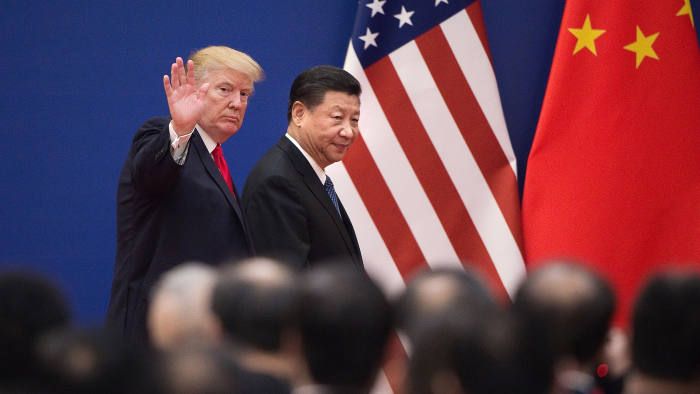Phase One of the US-China trade discussion is complete, according to the official statement of POTUS Donald Trump. Top negotiators from both countries spoke for hours over the telephone on Tuesday, sorting out the primary concerns. Both countries have agreed to continue working on their remaining differences. According to Trump’s statement, Washington is finalizing the deal that could potentially end the 16-month trade war with Beijing.
As a result of the ongoing trade war, China’s industrial revenue declined considerably. China released a statement on Wednesday claiming its factories recorded the sharpest sales drop in October, compared to the previous eight months. Profits are down by 9.9% to 427.56 billion Yuan (~$60.74 billion) as slow demand at home begins to take its toll. The trade war has put additional pressure on the Chinese economy.
The Hong Kong Issue
Although trade discussions have been smooth so far, Trump seemed keen on the Hong Kong protests, which was one of the original concerns raised by the US leading to the trade war. During the Press meet outside the White House, Trump said, “We are close to finalizing a very important deal, and would like to see it go down smoothly in Hong Kong too.”
China summoned US Ambassador Terry Branstad on Monday, to complain against the Hong Kong Human Rights and Democracy Act, which was recently passed in the US Congress. China believes the bill meddles with the country’s internal affairs. Trump mentioned his grand ties with the Chinese President, Xi Jinping, expecting a favorable outcome in Hong Kong. The democrats won almost 90% of Hong Kong’s 452 district councils seats in the election held on Nov. 24.
“I believe President Xi can make it happen. I know him and I know he would like to make it happen.” Trump said, without disclosing his expectations from the Chinese President. In an interview with O’Reilly, Trump added, “I am holding up the discussion as it needs to be a good deal. We cannot have a deal that is simply even. We need a much better deal since we need to catch up.”
Trump’s motivational comments reflected on Wall Street, with three of the largest indices breaking all-time highs on Tuesday. The Asian market reflected the gains on Wednesday with Japan’s Nikkei rising 0.41% while MSIC’s Asia Pacific shares outside Japan grew by 0.14%. The Australian market reflected a 0.46% growth.
Trade Negotiations in-Person
According to the Chinese Commerce Ministry, Trump’s remarks on Tuesday were closely followed by a telephone call from US Treasury Secretary Steven Mnuchin and Trade Representative Robert Lighthizer with Chinese Vice Premier Liu He. The negotiators discussed concerns and reached common ground on resolving the issue.
Phase one of the trade discussions was scheduled to be completed by November. However, analysts and people close to the White House expected a slight delay considering China’s demand for greater tariff rollbacks. This includes the 25% tariff imposed on Chinese industrial and consumer goods imported into the US before Sept. 1, 2019, and 15% tariff levied on $125 billion worth of import post-September 1.
If phase one remained incomplete until Dec. 15, Trump could choose to act on his previous threat of implementing a 15% tariff on $160 billion imports from China. White House Advisor Kellyanne Conway said phase one was almost complete. Trump wanted to conduct the discussion in phases since this was a large and historic trade deal for the US.
Iowa Republican and Senate Finance Committee Chairman Chuck Grassley told reporters he believes the US-China trade debacle will end by the end of 2019. Beijing invited Munchin and Lighthizer for in-person talks and the pair have might take the offer if Washington sees a real chance of reaching a final agreement.
According to Reuters, the US Trade Representative and Treasury were unavailable for comment. A source familiar with the trade discussions revealed the US Officials might visit Beijing post the Thanksgiving holidays. Back in October, Trump had shown a keen interest to delve into phase two of the trade discussions quickly once phase one was in order. Phase two focuses on deeper issues related to China’s demand for US companies to hand over technology to direct Chinese rivals.
The US and Chinese officials have clearly stated such follow-on negotiations might be difficult considering the hovering US Presidential Elections scheduled for November 2020. “We will continue to negotiate. But the theft of intellectual property, forced technology transfer and trade deficit of more than half a trillion per year with China – the world’s second-largest economy- makes zero sense for the US” Conway added. “The President wants a deal. But he always waits for the best deal”.
According to Beijing’s official statement, Central Bank Governor Yi Gang, Commerce Minister Zhong Shan and Vice Head of State Planning Ning Jizhe were also part of the trade negotiation.
UP NEXT: Apple could be exempted from China Tariffs; It’s probably because of Samsung
(source)






